Takeaway: Exploring creativity through art therapy activities can be a powerful outlet for individuals of all ages seeking to navigate the complexities of anxiety. In this post, I’ll be sharing a curated selection of therapeutic art exercises you can try from the comfort of your own home. Additionally, I’ll provide some insights on recognizing signs that might indicate the potential need to seek the support of an art therapist. Let’s dive in!
Have you ever noticed how you feel a bit calmer when you’re doodling or lost in the world of coloring books? What if I told you that this simple act of creating art could be a key to unlocking deeper emotional healing and understanding?
Welcome to the world of anxiety art therapy, a place where your creative pursuits aren’t just a hobby, but a powerful tool for mental well-being. Unlike just any art-making activity, art therapy for anxiety is a structured approach recognized by the American Art Therapy Association. It’s all about using creative expression to tackle those nagging worries that can take over our minds.
In this article, we’re going to explore how art therapy works, its benefits, and some active art-making you can try at home. Whether you’re dealing with day-to-day stress or more complex emotions, art therapy offers a unique and creative path to finding peace and understanding within yourself.
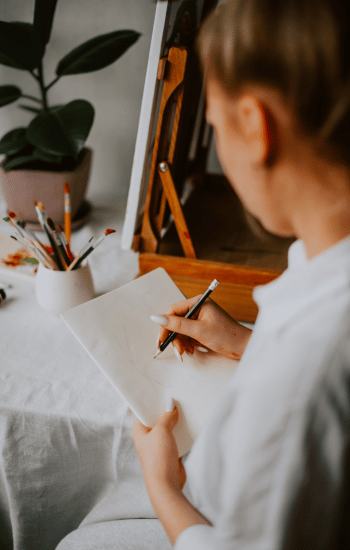
What is art therapy?
Art therapy for anxiety is a bit like using art for a special purpose – to help you feel better, physically, emotionally, and mentally. It’s more than just your regular drawing or painting session; it’s about using these creative activities to work through your feelings and stress. It’s like having a conversation, but instead of using words, you’re using art to express yourself.
Now, you might wonder, “Isn’t this the same as when I sketch or craft at home to relax?” Well, there’s a small difference. Doing art on your own is definitely a fantastic way to unwind and let out your emotions. It’s like a personal form of self-care, which is really important.
However, art therapy takes this a step further. It’s done with the help of a trained therapist – someone who knows a lot about both art and how to help people deal with their emotions.
In art therapy, the therapist guides you through specific art activities designed to help you with any challenges you’re facing, like anxiety or feeling low.
It’s a bit like having a guide who helps you navigate through your emotions, using art as the map. They use their knowledge to help you understand what you’re feeling and find new ways to cope.
So, while making art at home is a great way to take care of yourself, art therapy is a more structured form of using art for emotional and mental well-being, guided by a professional. It’s a powerful form of self-expression to explore your feelings and work through them in a creative and supportive setting.
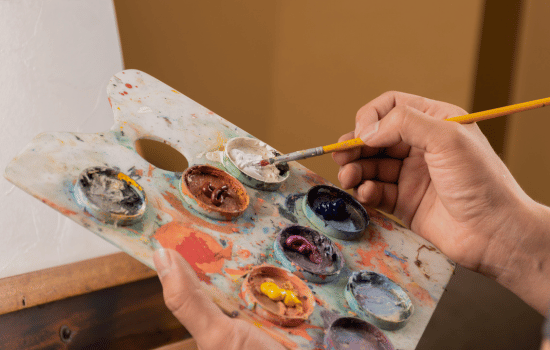
How can art therapy help with anxiety?
Alright, let’s talk about how art therapy can be a friend to those of us dealing with anxiety.
Anxiety is like having a little alarm in your head that goes off too often. It’s normal to worry about things now and then, but anxiety disorders such as generalized anxiety disorder, social anxiety disorder, or panic disorder are when these worries don’t go away and are so strong they mess with your daily life. This might look like feeling nervous all the time, having trouble sleeping or finding it hard to concentrate.
Art therapy is an effective treatment because it gives that alarm in your head a different job. Instead of worrying, you start creating. With art therapy, you don’t just chat about your feelings; you make art to express them. This could be through painting, drawing, sculpting – any form of art. It’s not about making a masterpiece; it’s about letting out what you’re feeling inside.
Now, why does this help with anxiety? When you’re focused on making art, your mind gets a break from all that worrying. It’s a bit like going on a mini-vacation.
When you’re engaged in this creative process, it’s like giving your nervous system a much-needed break. It helps bring you into a meditative state, shifting your focus from the whirlwind of anxiety to the calm of artistic expression.
This shift can provide immediate relief and help build emotional resilience. As you’re drawing or painting, you might find that you’re not thinking about your worries as much. This can calm your mind and body, making you feel less anxious.
Art therapy is also a way to understand your feelings better. Sometimes, it’s hard to put into words why you’re anxious. But when you create art, you find clues in your artwork about what’s bothering you. An art therapist – that’s someone trained to help you with art and talk about your feelings – can help you figure out these clues.
Remember, art therapy isn’t a magic cure. It’s like trying any new exercise for the first time; it might work great for some, but not as much for others. It’s a personal choice to use art therapy, and it’s okay if it takes time to see if it’s right for you.
So, whether you’re dealing with the everyday worries of life or something heavier, art therapists offer a creative and calming way to work through anxiety. Art therapy isn’t just about the art materials or the final product; it’s a journey of self-awareness, coping strategies, and psychological healing in a supportive therapy setting.
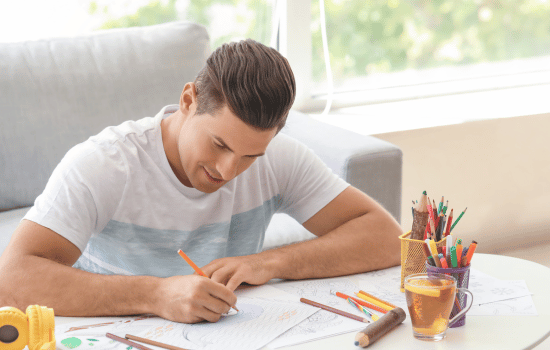
Benefits of using Art Therapy Exercises for Anxiety
You know, one of the coolest things about any art therapy exercise is that there’s no right or wrong way to make art. It’s all about what feels right for you and how it helps you deal with your anxiety.
A New Way to Express Yourself
Think of art as your personal language, one that doesn’t need perfect grammar or spelling. Whether it’s through a splash of paint, a simple sketch, or molding clay, each stroke or shape lets you express those tangled feelings inside. Art therapy exercise is all about getting those emotions out, without worrying about the ‘right’ way to do it.
Calms Your Nervous System
Ever noticed how time flies when you’re lost in coloring books or crafting? That’s your nervous system taking a breather. This happens because when you’re focused on art-making, your mind gets a chance to rest from the constant buzz of anxiety. And remember, there’s no ‘wrong’ way to color or craft. It’s all about what soothes you.
Boosts Your Self-Esteem
Here’s the thing: every piece of art you create is a victory, no matter how it looks. It’s a tangible reminder of your creativity and resilience. When it comes to art therapy for anxiety, it’s not about creating a gallery-worthy piece; it’s about the process and how it makes you feel. This is a great way to lift your spirits and boost your self-esteem.
Helps You Understand Yourself Better
As you create, you might start to notice patterns or symbols in your art that reflect your feelings. It’s like decoding a language that’s unique to you. This isn’t about making ‘correct’ art; it’s about letting your art help you understand your inner world better.
Offers a Greater Sense of Control
In the world of art making, you’re the boss. You decide every color, every line, every texture. This sense of control can be a big deal when you’re feeling overwhelmed by anxiety. It’s a reminder that, in the realm of creative expression, you call the shots, and there’s no pressure to do it the ‘right’ way.
So, grab those art materials and let your creativity flow. Remember, in art therapy, the journey of creating is just as important as the artwork itself. It’s a safe space where you can express, explore, and heal, all at your own pace and in your own unique way.
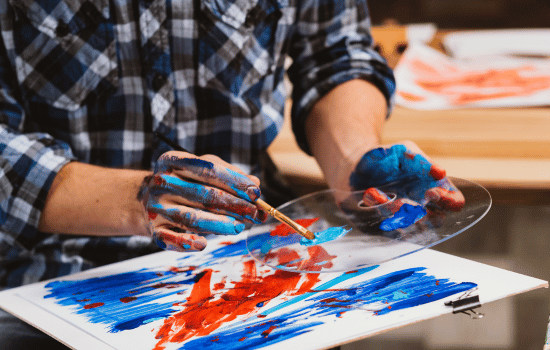
14 Art Therapy Activities that Help with Anxiety
If you’re struggling with anxiety, you might find some comfort in the world of art-making. These aren’t just any arts and crafts; they’re tools that can help soothe your mind and offer a creative outlet for those anxious feelings.From the focused calm of Zentangle drawing to the expressive freedom of painting to music, there’s a variety of activities you can easily do at home. They’re simple, effective, and a great way to explore your feelings through creativity. Ready to give it a try? Let’s explore some art therapy exercises that could help you find a little more self-confidence and a good deal more peace.
Therapeutic art activities to explore your creative expression
Let’s delve into anxiety art therapy activities, highlighting their specific benefits like promoting mindfulness, calming the mind, and more.
1. Mindful Doodling or “Doodle Meditation”
Materials Needed: Paper, pens, or markers.
Benefit: Promotes Relaxation and Mindfulness
Instructions: Sit in a quiet space with your various materials. Start doodling without any specific goal in mind. Let your hand freely move across the paper, creating lines, shapes, and patterns. Focus on the present moment and the movement of your pen, allowing your mind to relax and wander. You may want to fill in the lines with beautiful colors or make funny faces in the shapes.
2. Art Journaling
Materials Needed: Journal or sketchbook, various art supplies (pens, paints, collage materials).
Benefit: Facilitates Emotional Expression and Reflection
Instructions: Select a theme or topic that resonates with you for each journal entry. Write your thoughts and feelings about this topic. Then, use your art supplies to visually express these thoughts next to or around your writing. This could be through painting, drawing, or creating a collage that complements your words.
3. Mixed Media Art
Materials Needed: Various art supplies (paints, markers, collage materials, found objects).
Benefit: Encourages Experimentation and Expression
Instructions: Begin with a base, like a canvas or thick paper. Apply a layer of paint as a background. Once dry, add other elements like cut-out magazine pictures, fabric pieces, or even small objects. Use glue or other adhesives to attach these items. Experiment with layering different materials to create texture and depth.
4. Zentangle Drawing
Materials Needed: Paper, fine-point pens, or markers.
Benefit: Promotes Mindfulness and Stress Reduction
Instructions: Draw a small square on your paper. Within this square, draw several intersecting lines to create smaller sections. In each section, draw a repetitive pattern or design. Focus on each stroke and breathe deeply, enjoying the calming effect of this artistic process.
5. Writing and Decorating a Letter to Yourself
Materials Needed: Paper, pens, decorative materials (stickers, colored pens, glitter).
Benefit: Encourages Positive Self-Talk and Reflection
Instructions: Write a letter to yourself that includes positive affirmations, accomplishments, and future hopes. Once you’re done writing, use your decorative materials to embellish your letter. You might add borders, and illustrations, or highlight key phrases that are particularly meaningful.
6. Photography Walk
Materials Needed: Camera or smartphone.
Benefit: Enhances Mindfulness and Perspective
Instructions: Take a walk in an area you find interesting or beautiful. As you walk, look for unique patterns, colors, or scenes. Use your camera to capture these moments. Try to see the beauty in ordinary things and focus on the details that make your surroundings special.
7. Nature and Eco-Art Therapy
Materials Needed: Natural materials (leaves, twigs, stones, flowers), glue, paper, or canvas.
Benefit: Connects with Nature and Enhances Environmental Awareness
Instructions: Collect various natural items during a walk. Back in your creative space, arrange these items on your canvas or paper. You can create a specific scene, a pattern, or an abstract design. Glue the items down to create a permanent piece, or simply enjoy the process of arranging them temporarily.
8. Self-Portrait
Materials Needed: Mirror, paper, colored pencils, or painting materials.
Benefit: Fosters Self-Understanding and Acceptance
Instructions: Sit in front of a mirror in a well-lit room. Start by sketching the basic outline of your face and features. Then, fill in with details, colors, and textures that represent how you see yourself or how you are feeling at the moment. Remember, this doesn’t have to be a realistic portrait; it can be as abstract as you like. You can even use other materials or visual representations to trace your face or body outline.
9. Painting to Music
Materials Needed: Canvas or paper, paints, brushes, colored pencils, music player.
Benefit: Stimulates Emotional and Sensory Awareness
Instructions: Select music that evokes strong emotions or memories. As you listen, use your paints to express what the music makes you feel. Let the rhythm, melody, and mood guide your color choices and brushstrokes. You can paint abstractly or create images that the music inspires in you.
10. Sculpting with Clay
Materials Needed: Clay, sculpting tools (optional).
Benefit: Grounding and Emotional Release
Instructions: Start your clay modeling by kneading the clay to make it pliable. Then, begin shaping it according to your mood or feelings. You can create a specific object, an abstract form, or simply focus on the process of manipulation. Use sculpting tools if you wish to add details or textures. Bring awareness to how your body feels as you form the clay.
11. Digital Art Therapy
Materials Needed: Tablet, smartphone, or computer with digital art apps.
Benefit: Enhances Creativity and Accessibility
Instructions: Choose a digital art application that suits your interest. You can experiment with digital drawing, painting, or even 3D modeling. Play around with different tools and features offered by the app, like brushes, colors, and textures. Create an artwork that reflects your current mood or thoughts, enjoying the freedom and versatility of digital media.
12. Watercolor Meditation
Materials Needed: Watercolor paints, water-colored pencils, brushes, and watercolor paper.
Benefit: Promotes Relaxation and Mindfulness
Instructions: Set up a calm, comfortable space. Start by wetting your paper and then applying watercolor in gentle strokes. Focus on the flow of the paint and the blending of colors. Allow yourself to be present in the moment, letting go of structured designs, and enjoy the fluidity of watercolors as a meditative process.
13. Fabric Collage
Materials Needed: Various fabric scraps, scissors, glue, canvas, or sturdy paper.
Benefit: Enhances Creativity and Emotional Expression
Instructions: Cut the fabrics into shapes or strips. Arrange them on your canvas or paper to create an abstract or representational design. Glue the pieces down in a layout that feels expressive to you. This tactile activity allows for a creative exploration of textures and colors, providing a unique way to express emotions.
14. Shadow Drawing
Materials Needed: Objects with interesting shapes, paper, pencils or markers, and a light source.
Benefit: Encourages Perspective Taking and Mindfulness
Instructions: For Shadow Drawing, set up your workspace in a well-lit area. Choose objects with interesting shapes and place them on or around a sheet of paper. Adjust a light source such as a lamp or use natural light to cast shadows of these objects onto the paper. Trace the outlines of these shadows with a colored pencil or marker, experimenting with the arrangement and lighting to create different effects. This creative process focuses on perspective, light, and shadow, offering a unique and mindful art experience.
Each art therapy exercise offers a unique form of expression and emotional exploration, providing therapeutic benefits such as stress reduction, mindfulness, and a deeper understanding of oneself.
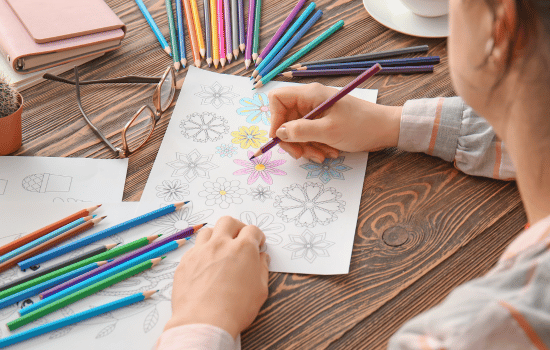
Understanding when you might benefit from working with a professional art therapist
Navigating the ups and downs of mental health can sometimes feel like trying to solve a puzzle without all the pieces. Particularly when dealing with anxiety symptoms or feeling anxious, art therapy exercises can be a helpful tool in your self-care kit.
However, there are times when these home-based activities might not be enough, and that’s okay. Recognizing when it’s time to seek the guidance of licensed professionals, art therapy can help in managing your mental health challenges more effectively. Let’s explore some key signs that indicate it might be beneficial to work with a mental health professional.
When Home Activities Aren’t Enough
If you’re engaging in art therapy exercises at home but still find yourself struggling with anxiety symptoms, it might be a sign to seek more structured, professional guidance. A mental health therapist can offer tailored support beyond what a self-guided art therapy exercise can provide.
Difficulty Expressing or Understanding Your Feelings
When you find it hard to articulate or understand your emotions, especially in the context of anxiety, professional guidance can be invaluable. An art therapist can help you explore and express these feelings through creative means, enhancing your self-awareness and emotional clarity.
Encountering Negative Thoughts and Behaviors
If you notice that negative thoughts and behaviors consistently impact your daily life, this may indicate a need for professional intervention. An art therapist can assist in transforming these patterns into more positive and constructive ones, using creative strategies.
Overwhelming Stress or Anxiety Impacting Daily Life
When your stress or anxiety symptoms significantly interfere with your daily activities, relationships, or work, professional help can be crucial. An art therapist can collaborate with you to develop effective coping skills and strategies for managing anxiety in everyday situations.
Coping with Trauma or Deep-Seated Issues
If your anxiety is related to past trauma or deeply ingrained issues, professional mental health support becomes even more important. Art therapists are trained to navigate these complex emotions and can help you use art as a tool for healing and expression.
Persistent Anxiety Symptoms and Frequent Panic Attacks
Experiencing ongoing anxiety and frequent panic attacks is one of the more challenging situations where professional help is essential. An art therapist can offer specialized techniques to manage and alleviate these intense panic attack symptoms, helping to improve your mental health and quality of life.
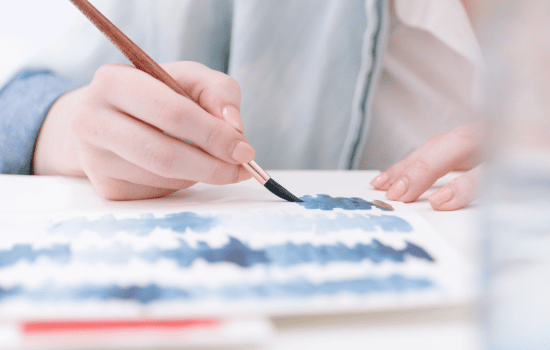
Start your healing journey with Art & Anxiety Therapy at Willow Mark Therapy
At Willow Mark Therapy, we’re not just about individual talk therapy sessions; we also offer special art therapy workshops that focus on wellness and self-care. Think of these workshops as your creative getaway – a space where you can explore art in a group setting while focusing on feeling good and taking care of yourself.These workshops are all about using art as a tool for relaxation and personal growth. Whether you’re painting, sculpting, or trying out a new form of art, it’s all done in a supportive, friendly atmosphere. You’ll get to meet others who are on their own journey of self-care and wellness, making it a great way to share happy moments and learn from each other.If you’re looking for a different way to unwind, de-stress, and give yourself some much-needed attention, our expressive art workshops might be just the thing. They’re designed to be easygoing and accessible, no matter your skill level. It’s all about taking a break, enjoying the process of creating, and discovering new ways to look after your mental well-being.Interested in joining one of our art therapy workshops? We’d love to have you! Reach out to us at Willow Mark Therapy to find out more about our workshop schedules and themes. It’s a wonderful opportunity to focus on your wellness journey in a creative, inclusive, and fun environment. Let’s explore the healing power of art together!